Yew Tree Care Guide: Gorwing Yew Tree Plant
Written by Iris
Oct 11 2021
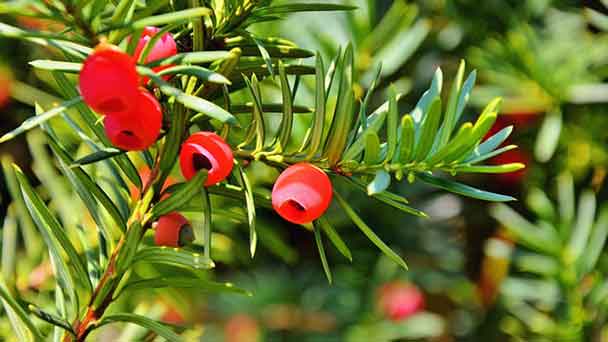
Yews are an evergreen tree that is often seen as a manicured shrub rather than a tree, but being able to grow one in time plays a vital role in every garden. While we love color and variety, it's just as important to keep dark greens calm in a balanced garden, and yew trees certainly have that and can grow anywhere in the garden.
Should the Yew tree leaves fall, there need be no cause for alarm; it is one of Nature's means of assisting recovery. If, however, the leaves shrivel or turn brown and remain on the branches, root action is not proceeding in a satisfactory way. In such a case, cut the branches back, spray the trees several times a day, and shade from the sun until new shoots appear. Severe pruning, when required by old trees, should be done in March or April.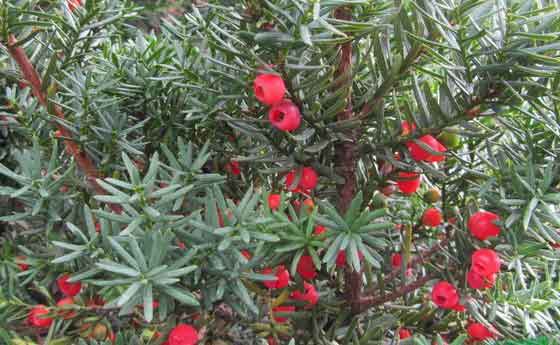
Get a loose, damp, but not wet soil medium such as sterile potting soil or peat moss and mix with the seeds you want to sprout. Two cups of the medium should be fine for all but a huge amount of seeds.
Put the yew tree seeds and medium in a large enough zip-lock type freezer bag that will hold the two cups of the medium. Seal the bag and poke 3 or 4 pencil lead sized holes in the bag and write the date on the bag.
Put this in a spot out of direct or strong light for 6 months at room temperature - as close to 20 Celsius or 68 Fahrenheit as possible.
Next, put the bag in your fridge (not the freezer) for 10 months. Take a look occasionally starting after 6 months to see if any of the seeds have rooted. If so, take the seed out and put it in a 10 cm (4 inches) pot of its own with a mix of compost and sand. Bury the seed about 1 cm (3/8 inch) deep, and be careful not to break the root. Put in a bright, non-direct sun spot and keep the soil moist.
After 10 months, plant all the seeds as above.
If after the first year some of the seeds don't sprout, leave them outside in a shady area, keep moist and leave until they sprout - winter and summer. It can take years for all of them to sprout.
First, get 10 cm (4 inch) pots and 3/4 fill with compost and sand for the soil mix.
Take Yew tree cuttings of 10-15 cm (4-6 inches) long new growth (green twig), and pull off all the leaves of about half of it on the lower end of each one.
Make a hole in the soil with your finger or a pencil in each pot, and put the lower end of the cutting in the soil, so that half is above the soil, half in the soil.
Gently firm the soil around the cutting to make full contact with the soil, but don't pack it down hard.
Water, and put in good light, but not direct sun. Keep the soil moist.
Cuttings root easily, and most should take without issue. Don't let the cutting in the pot get frost.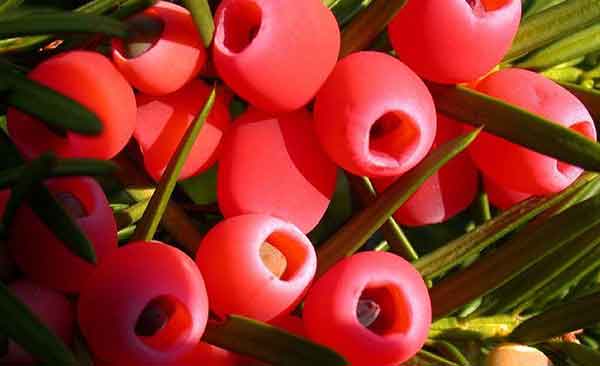
The following you should know about proper pruning:
Root rot
If waterlogging has been developed by too much moisture, the yew tree mostly reacts instantly with root rot. You can plan out small yews and let the root bale dry for approximately two days. Cut the rotten parts of the root and subsequently replant the yew tree in fresh and dry soil. Usually, the yew tree recovers again.
In addition, pests that infest yews in particular do not exist. However, lice occasionally appear in the yew hedges, especially if lice-infested plants are in the immediate surrounding, and then continue to spread on the yew. Mostly it is going about the brown scale that can get to the yew tree due to strong winds.
Brown scale
The brown scale is predominantly domestic in big cities and is named after its shield that resembles a scale. This ensures that even chemical insecticides cannot harm it in most cases. With alcohol, the shell can be softened so that insecticides can have a stronger effect.
The brown scale is recognizable due to the round brown surface, which is equipped with white dots. Primarily the brown scale takes roots in colonies at the plant stem and the leaves. They excrete honeydew which, in turn, results in a clogging of the leaves and these cannot absorb oxygen or light. Consequently, they die after the brown coloring of the leaves.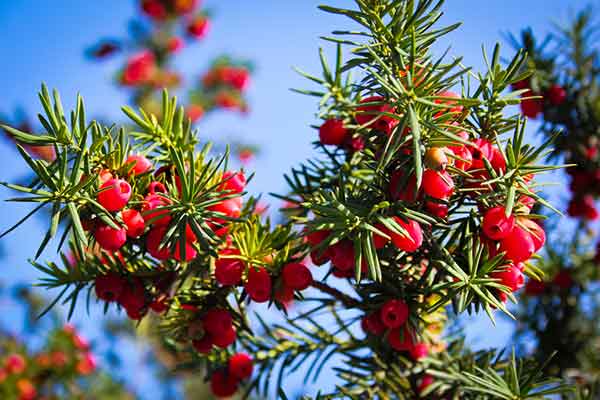
This very narrow, upright yew is deepest green. It is an ideal hedging plant, border specimen for small gardens, great in shady areas, too. Can be grown in containers. Great for formal design. H: 3-6 ft in 10 years W: 1 ft in 10 yrs Soil: Average Zone: 5
Hicks Yew
A narrow columnar to conical Yew with upright branches bearing dark glossy green foliage. Red berries. Great for formal hedges. Does well in sun or shade. Prune to shape. H: 8-12 ft W: 3-4ft Soil Well Drained Zone 4B - 7A
Irish Golden Yew
Upright growing evergreen with green needles that are edged in golden yellow. Versatile and sought after for formal gardens. Great in planters. Very slow-growing. Also known as Taxus baccata stricta aurea. H: 4-6 ft / 10 yrs W: 1ft / 10 yrs Soil: Average Zone: 5
Taxus X Media Hm Eddie
Provides instant privacy hedging. Can handle full shade to light sun. H: 18-20 ft /20yrs W: 3.5 ft / 20 yrs
Taxus baccata ‘Repandens’
Spreading English Yew, height can be anywhere from 4 – 8 feet and wide sprawling and can grow 10 – 15 feet in width. Can be quite a draught tolerant once established, great in forest planting or where a wide sprawling hedge is required. H: 4-8 ft / 10-15 yrs W: 10-15 ft / 10-15 yrs
Flushing Parade Yew
Upright, very narrow growth habits, dark green needles, and slower growth rates make this yew unique. If used in urban areas or designs that require this growth habit. Berries can be producedd but are not common. Plant as speciment or narrow hedging option. Growths 6-12 inches per year. Prune to encourage fullness. H: 5-10 ft W: 1-2 Ft Soil: Moist, Well-Drained Zone: 5
Hillii Yew
This broad, compact pyramid is deepest green with a very tidy, uniform habit. Use in sun or shade for a gorgeous hedge or foundation plant. Yews are also great container plants! H: 6-8 ft, W: 2-3 ft / 10 yrs Soil, Well-Drained Zone: 5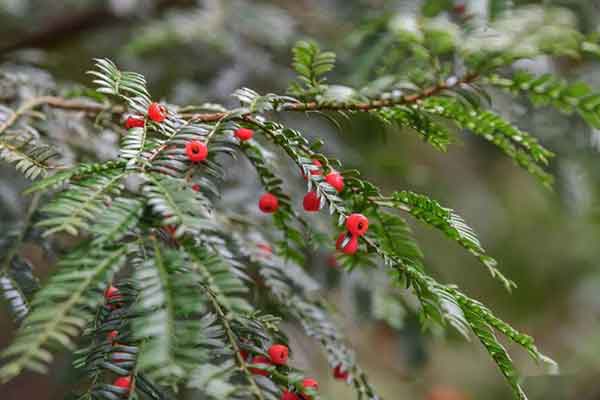
Where do Yew Tree GrowWhen to Grow Yew TreeHow to Grow Yew TreeYew Tree Propagation with SeedsYew Tree Propagation with CuttingsHow to Care for Yew TreeYew Tree Lighting RequirementsYew Tree Soil CareYew Tree WateringYew Tree Temperature & Humidity CareYew Tree FertilizerYew Tree PruningYew Tree Pests & DiseasesVarieties of Yew TreeYew Tree Care FAQIs Yew Tree Toxic?Why is the yew tree called the tree of death?
Where do Yew Tree Grow
The Yew tree is quite flexible in the choice of location. Yew tree is suitable for shady places as well as sunny spots. However, optimal is a half-shady location. If it is too dark, the growth rate decreases. In sunny locations, especially with alternating rain/snow and strong solar radiation, it can result in drying up. Especially young yews react hypersensitively to strong and direct sun radiation. Yew trees with high growth are to be wind protected. Strong winds could bend a grown peak shape apart.When to Grow Yew Tree
When the Yew trees are moved with a mass of soil attached to the roots, transplanting may be carried out in early autumn or early spring or, in mild climates, in winter; however, when there is considerable root disturbance, September and April are the best months for the work. Whether specimen or hedge plants are planted, the ground should be prepared beforehand and, if there is any danger of waterlogging, arrangements must be made for draining the ground. If, when the trees are received, the roots appear to be dry, soak them with water before planting, and give them a good watering as soon as the work is completed. If the weather is hot and dry the trees should be shaded from the hot sun for a week or two and sprayed twice a day with water. The removal of the ends of some of the branches will assist in re-establishing the trees by lessening the strain on the roots.Should the Yew tree leaves fall, there need be no cause for alarm; it is one of Nature's means of assisting recovery. If, however, the leaves shrivel or turn brown and remain on the branches, root action is not proceeding in a satisfactory way. In such a case, cut the branches back, spray the trees several times a day, and shade from the sun until new shoots appear. Severe pruning, when required by old trees, should be done in March or April.

How to Grow Yew Tree
Yew Tree Propagation with Seeds
Though you can grow Yew tree from seed, it is a very long, precise series of steps that you cannot get wrong or you will have to start again.Get a loose, damp, but not wet soil medium such as sterile potting soil or peat moss and mix with the seeds you want to sprout. Two cups of the medium should be fine for all but a huge amount of seeds.
Put the yew tree seeds and medium in a large enough zip-lock type freezer bag that will hold the two cups of the medium. Seal the bag and poke 3 or 4 pencil lead sized holes in the bag and write the date on the bag.
Put this in a spot out of direct or strong light for 6 months at room temperature - as close to 20 Celsius or 68 Fahrenheit as possible.
Next, put the bag in your fridge (not the freezer) for 10 months. Take a look occasionally starting after 6 months to see if any of the seeds have rooted. If so, take the seed out and put it in a 10 cm (4 inches) pot of its own with a mix of compost and sand. Bury the seed about 1 cm (3/8 inch) deep, and be careful not to break the root. Put in a bright, non-direct sun spot and keep the soil moist.
After 10 months, plant all the seeds as above.
If after the first year some of the seeds don't sprout, leave them outside in a shady area, keep moist and leave until they sprout - winter and summer. It can take years for all of them to sprout.
Yew Tree Propagation with Cuttings
You can propagate Yew tree as many as you want from cuttings:First, get 10 cm (4 inch) pots and 3/4 fill with compost and sand for the soil mix.
Take Yew tree cuttings of 10-15 cm (4-6 inches) long new growth (green twig), and pull off all the leaves of about half of it on the lower end of each one.
Make a hole in the soil with your finger or a pencil in each pot, and put the lower end of the cutting in the soil, so that half is above the soil, half in the soil.
Gently firm the soil around the cutting to make full contact with the soil, but don't pack it down hard.
Water, and put in good light, but not direct sun. Keep the soil moist.
Cuttings root easily, and most should take without issue. Don't let the cutting in the pot get frost.

How to Care for Yew Tree
Yew Tree Lighting Requirements
Yew plants can be grown in partial shade, even full shade. Preferring the shader spaced in the mountain garden, they brighten the north side of tall walls and stucco homes. Yew tree grows well under the canopy of other trees and among pine forests.Yew Tree Soil Care
Test the soil at the planting site using a soil pH test kit. Amend the soil with a 6-inch-thick layer of mildly acidic compost and a liberal sprinkling of horticultural sulfur if the pH is 7.5 or higher. Amend the soil with a 6-inch-thick layer of neutral compost and a liberal sprinkling of dolomitic lime if the pH is 6 or lower. Work the amendments into the soil to a depth of 12 to 15 inches.Yew Tree Watering
Water your yew tree weekly in dry weather for the first year after you plant it. During drought, or if your established yew tree grows beneath deep eaves or elsewhere that rain doesn't reach, water every week to 10 days during the spring-to-late-fall growing season. Never water enough that the soil gets soggy.Yew Tree Temperature & Humidity Care
Yew trees grow in all cold climate conditions in zones 2-8. In scorching summer weather, the shrubs will appreciate more water and shade. Humidity typically isn’t a problem for yews, though they can struggle in scorching, humid summer weather.Yew Tree Fertilizer
Wait a year after planting to fertilize your yew shrub in early spring. If you're in a frost-free area, feeding in late fall is acceptable. Fertilize with 1/4- to 1/2-inch mulch of well-composted manure; increase that to 1 inch if your soil is poor. Spread the manure to the shrub's drip line, where rain falls from the outer branches. Another option is granular, high-nitrogen 12-6-4 fertilizer. Scratch the granules evenly into the soil around its base, keeping them at least 1 foot from the trunk and extending to the drip line. Water them in when you're done. Feed 1/3 pound of fertilizer per 1 foot of the larger of your shrub's width or height. If the larger measurement is 5 feet, for example, use 1 2/3 pounds.Yew Tree Pruning
In order not to have to wait for a fully-grown overall appearance for years, regular pruning for yew tree is to be carried out once a year, radical pruning every couple of years.The following you should know about proper pruning:
- particularly yews, which grow slowly, are to be pruned once a year.
- the perfect time for pruning is spring because afterwards the budding follows and the yew is densely-grown in summer again
- it is not to be cut after the end of June
- hedge cuts are carried out conveniently with an electric hedge trimmer
- for even, straight cuts the stretching of rope is recommended
- wear always gloves because apart from the fruit pulp everything in a hedge is poisonous
- prune possibly frozen shoots in spring
- if the yew has become very bald, radical pruning will be necessary
- for radical pruning cut all branches at least to half or to 10 centimetres
Yew Tree Pests & Diseases
The yew hedge does not rank among the robust and insensitive plants. Species-specific diseases do not exist. Predominantly a wet keeping leads to diseases.Root rot
If waterlogging has been developed by too much moisture, the yew tree mostly reacts instantly with root rot. You can plan out small yews and let the root bale dry for approximately two days. Cut the rotten parts of the root and subsequently replant the yew tree in fresh and dry soil. Usually, the yew tree recovers again.
In addition, pests that infest yews in particular do not exist. However, lice occasionally appear in the yew hedges, especially if lice-infested plants are in the immediate surrounding, and then continue to spread on the yew. Mostly it is going about the brown scale that can get to the yew tree due to strong winds.
Brown scale
The brown scale is predominantly domestic in big cities and is named after its shield that resembles a scale. This ensures that even chemical insecticides cannot harm it in most cases. With alcohol, the shell can be softened so that insecticides can have a stronger effect.
The brown scale is recognizable due to the round brown surface, which is equipped with white dots. Primarily the brown scale takes roots in colonies at the plant stem and the leaves. They excrete honeydew which, in turn, results in a clogging of the leaves and these cannot absorb oxygen or light. Consequently, they die after the brown coloring of the leaves.

Varieties of Yew Tree
Melford YewThis very narrow, upright yew is deepest green. It is an ideal hedging plant, border specimen for small gardens, great in shady areas, too. Can be grown in containers. Great for formal design. H: 3-6 ft in 10 years W: 1 ft in 10 yrs Soil: Average Zone: 5
Hicks Yew
A narrow columnar to conical Yew with upright branches bearing dark glossy green foliage. Red berries. Great for formal hedges. Does well in sun or shade. Prune to shape. H: 8-12 ft W: 3-4ft Soil Well Drained Zone 4B - 7A
Irish Golden Yew
Upright growing evergreen with green needles that are edged in golden yellow. Versatile and sought after for formal gardens. Great in planters. Very slow-growing. Also known as Taxus baccata stricta aurea. H: 4-6 ft / 10 yrs W: 1ft / 10 yrs Soil: Average Zone: 5
Taxus X Media Hm Eddie
Provides instant privacy hedging. Can handle full shade to light sun. H: 18-20 ft /20yrs W: 3.5 ft / 20 yrs
Taxus baccata ‘Repandens’
Spreading English Yew, height can be anywhere from 4 – 8 feet and wide sprawling and can grow 10 – 15 feet in width. Can be quite a draught tolerant once established, great in forest planting or where a wide sprawling hedge is required. H: 4-8 ft / 10-15 yrs W: 10-15 ft / 10-15 yrs
Flushing Parade Yew
Upright, very narrow growth habits, dark green needles, and slower growth rates make this yew unique. If used in urban areas or designs that require this growth habit. Berries can be producedd but are not common. Plant as speciment or narrow hedging option. Growths 6-12 inches per year. Prune to encourage fullness. H: 5-10 ft W: 1-2 Ft Soil: Moist, Well-Drained Zone: 5
Hillii Yew
This broad, compact pyramid is deepest green with a very tidy, uniform habit. Use in sun or shade for a gorgeous hedge or foundation plant. Yews are also great container plants! H: 6-8 ft, W: 2-3 ft / 10 yrs Soil, Well-Drained Zone: 5

Yew Tree Care FAQ
Is Yew Tree Toxic?
Yew plants create an extremely toxic compound in all parts of the plant, except for the fleshy red fruit they produce. This serves as a self-defense mechanism to help prevent animals from eating them. Except for a few animals that have adapted to the toxin and can eat them (sadly, deer are not susceptible to the toxin), this toxin will affect almost all animals. So be careful where you plant these shrubs.Why is the yew tree called the tree of death?
A popular legend relates how Pontius Pilate was born under this tree or played as a child in its branches. Drooping branches of old yew trees can root and form new trunks where they touch the ground. Thus the yew came to symbolise death and resurrection in Celtic culture.Latest Updated
- Benefits of Bugleweed - 7 Science-backed Health Benefits
- Bugleweed Dangers & Side Effects - Is It Poisonous?
- How to Plant Evergreen Trees - What You Should Know
- When to Plant Evergreens - Grow Guide for Evergreen Trees
- 12 Wonderful Evergreen Shrubs for Your Garden
- 12 Popular Evergreen Plants with Pictures for Beginners
- When And How To Prune A Lilac Bush Like a Pro
- How to Grow & Care for Lilac Vine (Hardenbergia Violacea)
- Japanese Lilac Tree (Syringa Reticulata) Care & Propagation Guide
- Shumard Oak Pros and Cons - What to Know
Popular Articles
- Winter maintenance of Antirrhinum Majus
- How to Grow Terminalia Mantaly Tree
- How to Grow and Care for Crossostephium Chinense
- How to grow Antirrhinum Majus in spring
- Peristeria Elata (Dove Orchid) Profile: Info & Care Guide
- Underwatered Snake Plant (Sansevieria Trifasciata) - Signs And How To Fix
- How to Care for Brazilian Jasmine Plant (Mandevilla Sanderi)
- How to Grow & Care for Graptopetalum Purple Delight in Summer
- Rosa Chinensis (China Rose): Plant Growing & Care Tips
- How to Care for Baby Sun Rose (Aptenia Cordifolia)